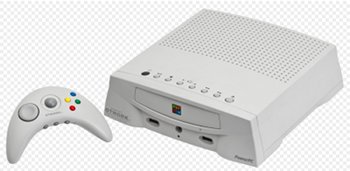Bandai Pippin
Early in the 1990s, there were many corporations who had been in the computer market and had now exited since PCs were becoming the norm. Instead, they used their technologies and devices to enter the gaming industry, hoping to capitalize in this new market where consoles almost grew on trees, and advances being made very quickly.
Apple also decided to try and get a piece of the action, and they released a new generation of the Power Macintosh, slimming it down to a console so that it would be inexpensive and appealing to gamers. This console was then licensed out to others in order to market the device.
This was the Pippin technology, and the first company to get on-board was Bandai who created the Bandai Pippin, releasing it in Japan in 1995. The original idea was that the Pippin would support not only games but also normal computer tasks. Basically, this is a Macintosh computer hardware, with a PowerPC 603 processor and enough power to produce graphics and gameplay that could rival the PlayStation. A Norwegian business even licensed this technology for the European market, a console that retailed for around 550 pounds.
While the Pippin was supposed to be a powerful computer as well as a game console, and Apple had the intention of introducing a lot of educational software, the failure of the 3DO scared the company into changing this strategy. Instead, they sold it as an Internet-connected device. This was the time when the Internet was really taking off and as such they needed a device that could take advantage of it. The Bandai Pippin was introduced as an Internet appliance that also played games.
Unfortunately this proved to be a failure. The problem was that PCs were becoming the de facto hardware people used to go online, and they could be bought very cheaply. The Pippin was more expensive and did less, which made it pointless as an Internet device. Eventually, they rethought that strategy and tried to market it as a set top box, an all-in-one system that allowed users to go online, play multimedia presentations and play games. But by that time Bandai stopped supporting the system and moved on to other projects. In all, less than 12,000 systems were sold around the world.
This was a lesson for the companies at the time that gaming consoles were simply not ready to be all-in-one systems. Gamers wanted powerful machines that could play the latest games, and cost as little as possible. By adding all of the additional hardware to be a true computer, it failed as a game console, and still could not compete with PCs. Right now it has become a very rare system to find since so few devices were produced. This was a very short foray from Apple into the gaming console market. Most of the reviews were fairly bleak and the marketing effort was almost inexistent.
Developer: Apple / Bandai
Games Released: 85
Release Price: $599
CC Image courtesy of Evan-Amos / Source: Wikipedia
[shareaholic app="share_buttons" id="4703992"][shareaholic app="recommendations" id="4704000"]

